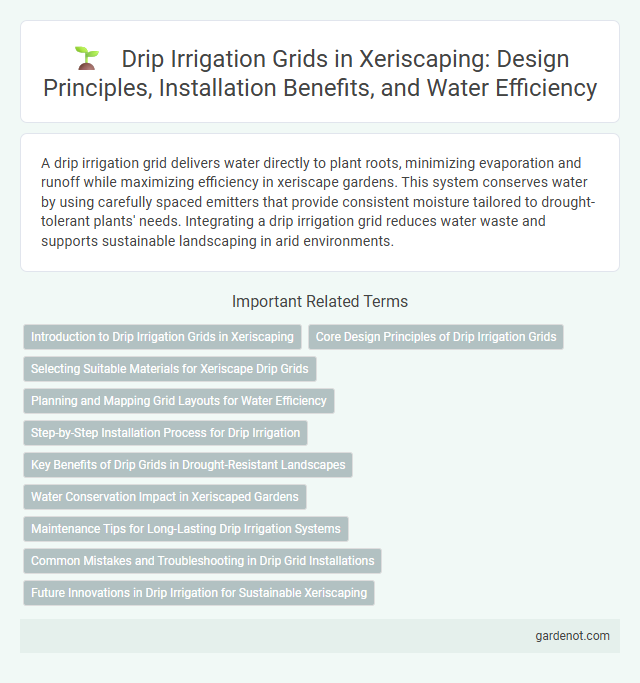A drip irrigation grid delivers water directly to plant roots, minimizing evaporation and runoff while maximizing efficiency in xeriscape gardens. This system conserves water by using carefully spaced emitters that provide consistent moisture tailored to drought-tolerant plants' needs. Integrating a drip irrigation grid reduces water waste and supports sustainable landscaping in arid environments.
Introduction to Drip Irrigation Grids in Xeriscaping
Drip irrigation grids in xeriscaping efficiently deliver water directly to plant roots through a network of emitters, reducing water waste and evaporation. These systems optimize water usage by targeting specific areas within drought-resistant landscapes, promoting healthy growth while conserving moisture. Incorporating drip irrigation grids supports sustainable landscaping by minimizing runoff and ensuring precise hydration for xeriscape plants.
Core Design Principles of Drip Irrigation Grids
Drip irrigation grids optimize water efficiency by delivering precise moisture directly to plant roots, minimizing evaporation and runoff. Key design principles include uniform emitter spacing tailored to soil type and plant water requirements, ensuring consistent coverage and root zone saturation. Incorporating pressure regulation and filtration components enhances system durability and maintains optimal flow rates for sustained irrigation performance.
Selecting Suitable Materials for Xeriscape Drip Grids
Selecting suitable materials for xeriscape drip irrigation grids requires prioritizing durability and water efficiency to support arid landscaping needs. High-quality polyethylene tubing, pressure-compensating emitters, and corrosion-resistant fittings ensure precise water delivery while minimizing leaks and evaporation. Using UV-resistant components and appropriate filters further enhances system longevity and maintains consistent performance in xeriscape environments.
Planning and Mapping Grid Layouts for Water Efficiency
Planning and mapping drip irrigation grid layouts require precise spacing to match plant water needs and soil types for optimal water efficiency. Incorporating contour lines and slope gradients helps reduce runoff and ensures uniform water distribution across xeriscape landscapes. Detailed mapping with digital tools enables precise emitter placement, minimizing water waste and promoting sustainable irrigation practices.
Step-by-Step Installation Process for Drip Irrigation
Begin the drip irrigation installation by mapping your xeriscape garden to determine plant zones and water needs, ensuring efficient water distribution. Next, lay out the main supply line and connect drip tubing, installing emitters near the root zones of drought-tolerant plants to optimize moisture delivery. Finally, test the system for leaks and adjust emitter flow rates to maintain consistent irrigation, promoting water conservation in xeriscape landscapes.
Key Benefits of Drip Grids in Drought-Resistant Landscapes
Drip irrigation grids deliver precise water directly to plant roots, significantly reducing water waste in xeriscape gardens. Their efficient design minimizes evaporation and runoff, making them ideal for drought-resistant landscaping by conserving water resources. This targeted hydration promotes healthier plant growth while lowering irrigation costs and conserving energy.
Water Conservation Impact in Xeriscaped Gardens
Drip irrigation grids significantly enhance water conservation in xeriscaped gardens by delivering water directly to plant roots with minimal evaporation or runoff, reducing water waste by up to 50-70% compared to traditional sprinkler systems. These systems allow precise control over watering schedules and distribution, supporting the drought-resistant nature of xeriscape plants while maintaining soil moisture efficiently. Implementing drip irrigation in xeriscaping aligns with sustainable landscaping practices, optimizing resource use in arid and semi-arid environments.
Maintenance Tips for Long-Lasting Drip Irrigation Systems
Regularly inspect drip irrigation grids for clogged emitters and flush lines to prevent blockages, ensuring efficient water delivery. Replace damaged emitters and check for leaks around connectors and tubing to maintain system integrity. Seasonal adjustments, such as winterizing and removing debris, prolong the lifespan of drip irrigation systems in xeriscape landscapes.
Common Mistakes and Troubleshooting in Drip Grid Installations
Common mistakes in drip irrigation grid installations include uneven emitter spacing, insufficient pressure regulation, and failure to flush the system, leading to clogged emitters and poor water distribution. Troubleshooting involves checking for leaks, ensuring the pressure regulator is functioning correctly, and regularly cleaning filters to maintain optimal water flow. Proper design with appropriate grid spacing and use of quality components prevents water waste and enhances xeriscape efficiency.
Future Innovations in Drip Irrigation for Sustainable Xeriscaping
Future innovations in drip irrigation for sustainable xeriscaping emphasize smart technology integration, such as sensor-driven systems that optimize water delivery based on soil moisture and plant needs. Advanced emitters with self-cleaning mechanisms and adjustable flow rates reduce water waste and enhance efficiency in arid landscapes. Research on durable, biodegradable tubing materials also supports environmentally friendly practices in long-term xeriscape irrigation infrastructure.
Drip irrigation grid Infographic

 gardenot.com
gardenot.com